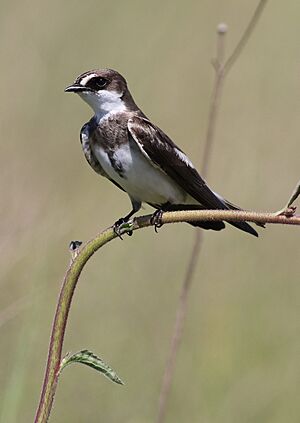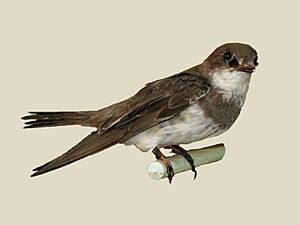Banded martin facts for kids
Quick facts for kids Banded martin |
|
|---|---|
 |
|
| At Rietvlei Nature Reserve, Gauteng, South Africa | |
| Conservation status | |
| Scientific classification | |
| Genus: |
Neophedina
|
| Species: |
cincta
|
The banded martin is a small bird from the swallow family, called Hirundinidae. It's also known as the banded sand martin. This bird lives only in Africa. Its scientific name is Neophedina cincta. It's the only species in its special group, called a genus, named Neophedina.
Contents
About the Banded Martin's Name
The banded martin got its first scientific name in 1783. A Dutch scientist named Pieter Boddaert gave it the name Hirundo cincta.
Later, scientists studied the bird's genes. They found it was different from other birds in the Riparia group. So, it was moved to its own group, Neophedina. This group was named by a South African scientist, Austin Roberts, in 1922. The word cincta comes from Latin. It means "banded," which describes the bird's look.
Different Types of Banded Martins
There are five known types, or subspecies, of the banded martin:
- N. c. erlangeri – Found in Ethiopia.
- N. c. suahelica – Lives from South Sudan to North Zimbabwe.
- N. c. parvula – Found in North Angola and parts of Congo and Zambia.
- N. c. xerica – Lives in West and South Angola, Namibia, and Botswana.
- N. c. cincta – Found in Southeast Botswana, South Zimbabwe, and South Africa. This is the original type.
What Does the Banded Martin Look Like?
The banded martin is about 15 to 17 centimeters long. That's about 6 to 7 inches. Its upper body is earth-brown. It has a white stripe above each eye.
Its belly and the feathers under its wings are white. A dark brown band crosses its chest. Sometimes, there's also a thin dark line near its tail. Male and female banded martins look very similar. Young birds have a lighter chest band. Their upper feathers have golden tips.
How to Tell Them Apart
It's easy to tell the banded martin from the smaller sand martin. The banded martin has a square tail. It also has white under its wings. The brown-throated sand martin has a white throat, unlike the banded martin. Banded martins usually fly in pairs or small groups. They are not as social as some other swallows.
The different types of banded martins vary a bit. They can be different sizes. Their upper parts or chest bands might have slightly different colors. The type found in southern Africa, R. c. cincta, is the palest.
Where Do Banded Martins Live?
Banded martins like open areas. You can find them in farmlands, grasslands, and savannas. They usually live near water. They breed across Africa. This includes places from Cameroon to Ethiopia. They also live south to the Cape in South Africa. However, they don't live in the driest parts of western South Africa or southern Namibia.
Do They Migrate?
The southern banded martins from South Africa and Zimbabwe migrate. They fly further north for winter. This is especially true in the west. Some even go as far as Gambia. The N. c. xerica type also leaves its dry breeding areas. This happens in Botswana and northern Namibia during the southern winter. Other types of banded martins move locally. Their movements often depend on how much rain falls.
Banded Martin Habits and Life
This bird flies slowly and unevenly. It often stops to perch. Banded martins eat insects. They usually catch them while flying over grasslands. Their flight call sounds like che-che-che. Their song is a mix of chip choop sounds.
Unlike other birds in its group, the banded martin does not nest in large groups. It builds its nest at the end of a long tunnel. This tunnel is usually 60 to 90 centimeters (about 2 to 3 feet) long. The birds dig it themselves. They often dig into natural sand banks or earth mounds. The nest itself is a bed of straw and feathers. It's built in a small room at the end of the tunnel. The female lays two to five white eggs. Both parents help to incubate, or warm, the eggs.



